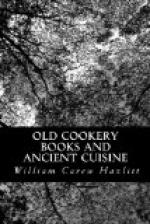Another rather prominent factor in the diet of the poor classes, not only in Scotland but in the North of England, was oatmeal variously prepared. One very favourable and palatable way was by grinding the meal a second time as fine as flour, boiling it, and then serving it with hot milk or treacle. There is something in the nature of this food so peculiarly satisfying and supporting, that it seems to have been destined to become the staple nourishment of a poor population in a cold and bracing climate. The fourteenth and fifteenth centuries unquestionably saw a great advance in the mystery of cookery and in the diversity of dishes, and the author of “Piers of Fulham” complains, that men were no longer satisfied with brawn and powdered beef, which he terms “store of house,” but would have venison, wild fowl, and heronshaw; and men of simple estate, says he, will have partridges and plovers, when lords lack. He adds quaintly:
“A mallard of the dunghill is good
enough for me,
With pleasant pickle, or it is else poison.
pardy.”
We have for our purpose a very serviceable relic of the old time, called “A Merry Jest, how the Ploughman learned his Paternoster.” The scene purports to be laid in France, and the general outline may have been taken from the French; but it is substantially English, with allusions to Kent, Robin Hood, and so forth, and it certainly illustrates the theme upon which we are. This ploughman was in fact a farmer or husbandman, and the account of his dwelling and garden-stuff is very interesting. We are told that his hall-roof was full of bacon-flitches, and his store-room of eggs, butter, and cheese. He had plenty of malt to make good ale—
“And Martlemas beef to him was not
dainty;
Onions and Garlic had he enough,
And good cream, and milk of the cow.”




